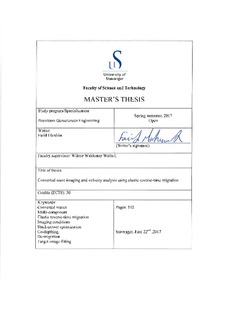| dc.contributor.advisor | Weibull, Wiktor Waldemar | |
| dc.contributor.author | Ebrahim, Farid | |
| dc.date.accessioned | 2017-11-07T10:05:39Z | |
| dc.date.available | 2017-11-07T10:05:39Z | |
| dc.date.issued | 2017-06-22 | |
| dc.identifier.uri | http://hdl.handle.net/11250/2464540 | |
| dc.description | Master's thesis in petroleum geosciences engineering | nb_NO |
| dc.description.abstract | Along the continuous evolution of exploration seismology, the main objective has been producing better subsurface seismic images that lead to lower risk exploration and enhanced production. The unique characteristics of converted (P-S) waves enable retrieving more accurate subsurface information, which made it play a complementary role in hydrocarbon seismic exploration, where the primary method of conventional compressional wave (P-P) data has limited capabilities. Conventional processing techniques of P-S data are based on approximations that do not respect the elastic nature of the subsurface and the vector nature of the recorded wave-fields, which urge the need for accurate modeling of subsurface velocity fields, and elastic imaging algorithm that can overcome the shortcomings following the conventional approximations. In this thesis we presented a novel workflow for accurate depth imaging and velocity analysis for multicomponent data. The workflow is based on elastic reverse-time migration as a robust migration algorithm, and automatic wave equation migration velocity analysis techniques. We practically tested novel imaging conditions for elastic reverse-time migration in order to overcome the polarity reversal problem and investigated the cross-talking between wave-modes. For velocity analysis we applied stack-power maximization to produce improved velocity fields that enhance the image coherency, then we applied co-depthing technique based on novel Born modeling/demigration method and target image fitting procedure in order to produce the shear-wave velocity model that result in depth consistent P-S and P-P images. We successfully implemented the workflow on synthetic and field datasets. The results obtained show the robustness and practicality of the workflow to produce enhanced velocity models and accurate subsurface elastic images. | nb_NO |
| dc.language.iso | eng | nb_NO |
| dc.publisher | University of Stavanger, Norway | nb_NO |
| dc.relation.ispartofseries | Masteroppgave/UIS-TN-IPT/2017; | |
| dc.rights | Navngivelse 4.0 Internasjonal | * |
| dc.rights.uri | http://creativecommons.org/licenses/by/4.0/deed.no | * |
| dc.subject | petroleumsteknologi | nb_NO |
| dc.subject | petroleum engineering | nb_NO |
| dc.subject | co-depthing | nb_NO |
| dc.subject | petroleum geosciences engineering | nb_NO |
| dc.subject | converted waves | nb_NO |
| dc.subject | petroleumsgeologi | nb_NO |
| dc.subject | multi-component | nb_NO |
| dc.subject | elastic reverse-time migration | nb_NO |
| dc.subject | stack-power optimization | nb_NO |
| dc.subject | co-depthing | nb_NO |
| dc.subject | de-migration | nb_NO |
| dc.subject | target image fitting | nb_NO |
| dc.title | Converted wave imaging and velocity analysis using elastic reverse-time migration | nb_NO |
| dc.type | Master thesis | nb_NO |
| dc.subject.nsi | VDP::Matematikk og Naturvitenskap: 400::Geofag: 450::Petroleumsgeologi og -geofysikk: 464 | nb_NO |
| dc.subject.nsi | VDP::Teknologi: 500::Berg‑ og petroleumsfag: 510::Geoteknikk: 513 | nb_NO |

